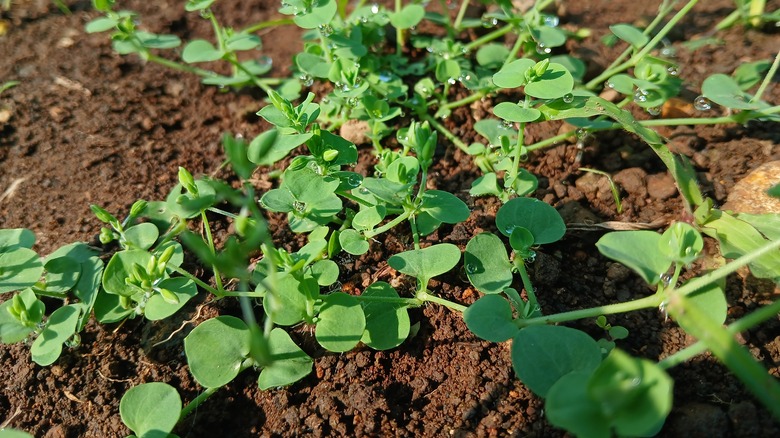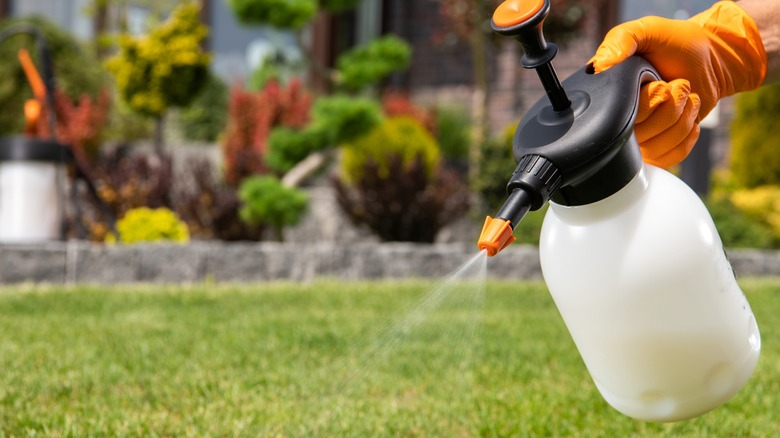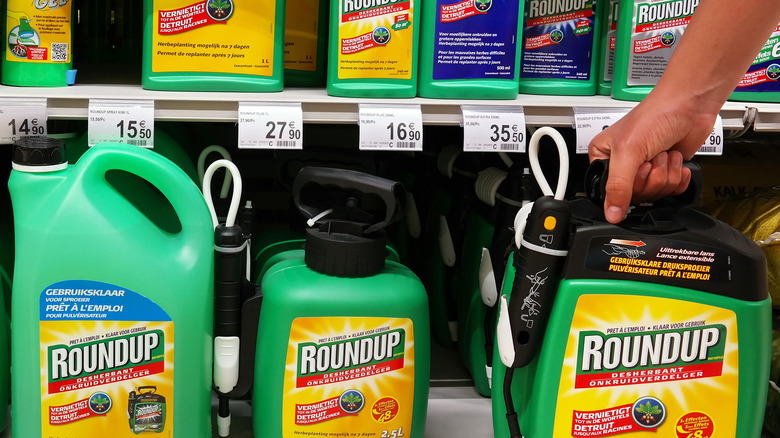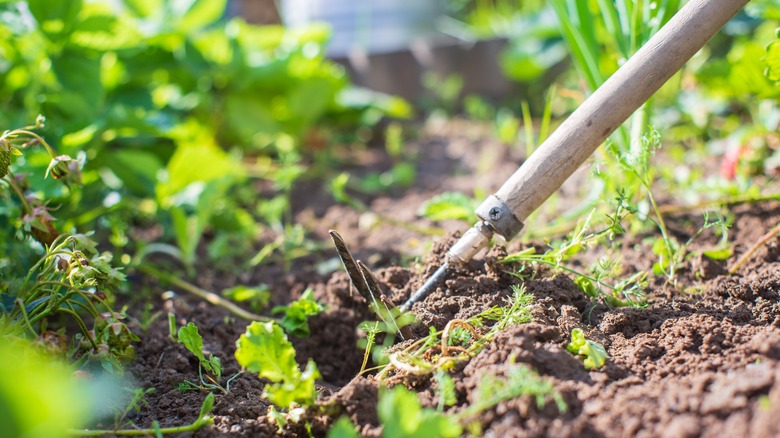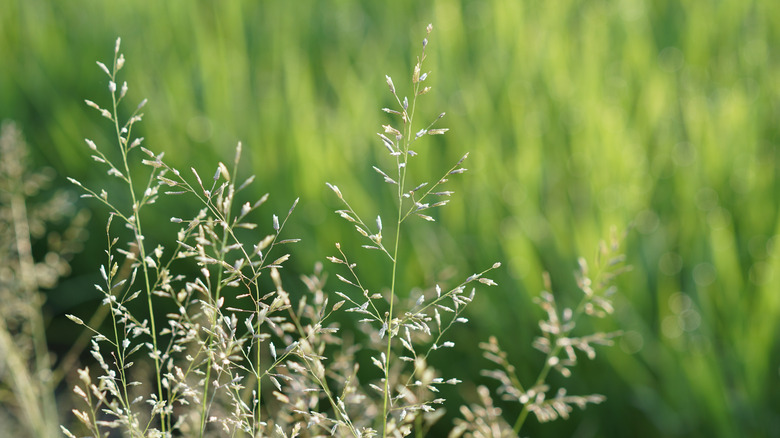Clever Tips For Getting Rid Of The Cool-Weather Annual Weeds In Your Yard
You may think of weed control as a spring or summer activity that coincides with the growing season for most of your plants. But not all weeds emerge during the year's warmest months. Cool-weather annual weeds (also known as "annual winter weeds") are pesky plants that begin to appear in the garden or lawn just as cold weather sets in. Common winter annual species include henbit, common chickweed, prickly lettuce, marestail, purple deadnettle, shepherd's purse, and annual bluegrass. These weeds are not easy to control, partly because they leave lots of seeds behind before dying for the season when warm weather returns.
There are several ways you can keep your yard free of these invasive plants. For instance, you can apply pre-emergent and post-emergent herbicides, pluck the weeds by hand, or cover them with mulch. Often, you'll need to use several of these strategies together to make better progress against these annoying invaders. Below, we'll share a few tips for making your fight against annual winter weeds more effective.
Maintain a healthy lawn to prevent winter weeds from emerging in the first place
Winter weeds are notoriously difficult to eradicate once they take root, and the easiest way to control them is to prevent them from taking over the space. This entails having a healthy lawn. Lawns with strong grass that grow vigorously generally don't experience issues with weeds, since they will block weed seedlings from accessing the nutrients they need to become established. On the other hand, there are several poor management practices that weaken lawns and give weeds a chance to thrive. Avoid these bad habits to keep your lawn healthy and competitive against the weeds.
One common issue is excessive compaction, which can significantly harm your lawn's soil health. When the lawn soil becomes extremely compacted due to foot (or vehicular) traffic, it blocks water access to the roots of the grass, and the lack of water stunts their growth. Likewise, compacted soil often leads to an overly thick thatch layer, which compounds the problem by further restricting water and nutrient flow to the roots. To avoid these problems, you have to aerate and dethatch your lawn. The best time to aerate your lawn or remove the thatch layer depends on the amount of traffic the lawn receives and the type of grass you have.
Improper watering can also deprive the grass of the strength it needs to combat encroaching weeds. Irrigation that doesn't cover the entire turf area evenly leaves spots of the lawn weak and vulnerable. Likewise, light, frequent irrigation keeps the grass roots short, and a less robust root system makes it easy for weeds to emerge and flourish. Instead, nourish the lawn with substantial but infrequent watering.
Don't rely on pre-emergent herbicides alone
Apart from maintaining a healthy lawn, pre-emergent herbicides offer the best control mechanism for managing annual winter weeds. This type of herbicide must be applied before the weeds sprout (normally just as summer transitions to fall). Alternately, a post-emergent herbicide acts as a germination inhibitor, so in theory, the annual weeds should never have a chance to even appear.
But this method has an important drawback. Winter annual weeds have a lengthy emergence period, meaning they take a long time to sprout. If you apply the pre-emergents early in the fall, a good portion of the herbicide will be washed away by the fall rains before the annual winter weeds start to germinate. This timing mismatch means that the pre-emergent herbicide will not be fully effective, and some weeds will be able to poke their heads through. So, instead of relying solely on pre-emergent applications, use this method in conjunction with other strategies for controlling annual cool-season weeds. For example, you can supplement pre-emergent herbicides with hand-pulling if you notice that some weeds are showing up despite the chemical treatment. Alternatively, spray problematic spots with post-emergent herbicides — just make sure they're effective in cold weather, and don't use them until your cool-season lawn is well-established.
If you're seeding a cool-season lawn, pull the weeds by hand as they germinate
Pre-emergent herbicides are one of the best weapons in the fight against cool-weather annual weeds. However, it's best not to use them if you're trying to germinate cool-weather turf — in fact, it's an easy way to kill the grass in your lawn. These herbicides will prevent the germination and growth of your cool season turf if you treat the soil with them shortly before seeding the lawn. Of course, you can try to wait and seed the lawn later in the year. However, if you wait long enough and the weather gets significantly cooler, it may well be too cold for the grass to germinate. So, unless you luck out, you'll probably struggle to find the sweet spot between the effectiveness of the pre-emergent herbicide and the vitality of your cool-season lawn.
If you're intent on growing cool-season grasses, your winter annual weed control options are rather limited, and hand-pulling may be the best way to go. This method also helps you grow a healthy lawn without relying on harsh chemicals. To be effective, you should hold the weeds as close to the root as possible before pulling them. However, unlike perennial weeds, annuals don't need the entire root to be pulled out during hand-weeding. As long as you rip the part of the root that's close to the soil surface, the weed will die. One word to the wise: wear gloves during this procedure. Some annual weeds (like prickly lettuce) are, well, prickly, and can hurt your hands if you handle them without protection.
If you must use herbicides on a cool-season lawn, choose the product with care
Hand-plucking is one of the least harmful ways to kill weeds in your cool-season lawn. But this method is not for everyone. Pulling weeds by hand is hard work that requires you to spend a great deal of time on your knees. If this labor-intensive method does not agree with you, or the weeds are multiplying faster than you can handle them with hand-plucking alone, you'll have to resort to chemical control methods. However, you'll need to choose herbicides that will not damage your cool-season lawn.
Fortunately, there are some pre- and post-emergent herbicides that are lawn-safe. For example, dithiopyr is a pre-emergent herbicide that's effective against broadleaf and grass weeds, but not harmful to turf grass. Meanwhile, isoxaben is a pre-emergent that's designed to fight broadleaf invaders while leaving most turf species alone. If you're looking for post-emergents, mesotrione is a safe choice for most cool-season grass species except for fine fescue.
As an added precaution, do not treat your weeds with these herbicides during bouts of excessive heat and dryness, or on particularly windy days. These weather conditions could cause the herbicides to transform into a gaseous form, spread beyond the treatment area, and harm nearby plants in your garden. Likewise, to minimize the effects of the herbicides on your turf, begin the applications only after you've mowed the lawn on three or more occasions. This way, the grass will be strong enough to not succumb to the chemicals the way the winter annuals do.
Get rid of winter annual weeds before they flower
Winter annuals are tough to eradicate because they produce a ton of seeds. You may think that the pesky plants are done with your yard when the hot weather kills them at the end of spring. But, alas, the seeds they've shed earlier in the season will remain in the soil unscathed until cooler days return. Then, as you head into fall, you'll be back to square one, with a yard-full of winter annual weeds.
The best way to interrupt this vicious cycle is to deny these weeds the opportunity to seed by destroying them before they flower. This means you have to be patient, keen, and observant. Even if you've treated your yard with pre-emergents, assume that some weeds will still find a way to germinate, and check your yard often for signs of these unwanted guests. Winter annual weeds generally don't bolt and flower until the end of spring, but there's no need to waste time and let them flourish and get established. As soon as any of them appear, dispatch them quickly by hand-pulling or with spot applications of post-emergent herbicide. Taking action promptly reduces the risk that these weeds' offspring will come back to haunt you the following year.
Treat annual bluegrass infestations as soon as possible
Annual bluegrass (Poa annua var. annua) is one of the most difficult winter weeds to get rid of. Its germination period starts with the fall and continues well into winter, after which point the grass blades can grow to a foot in height and begin flowering and seeding quickly. A single plant of this species easily produces over 100 seeds in the first two months of its life. It's no surprise then, that once annual bluegrass starts growing on a lawn or in an ornamental garden, it will propagate quickly. Mowing the infested areas, or walking about in your yard helps expedite the spread. If the bluegrass invasion spreads to your ornamental plants, the weed will form a thick layer and compete with the plants for nutrients.
To keep annual bluegrass from wreaking havoc in your garden, rip the weeds out as soon as they poke their heads through the soil. Identifying these weeds successfully may be tricky, but it's a challenge you'll have to overcome if you want to control their spread. The biggest obstacle lies in finding them growing in a cool-season lawn, as the weed physically resembles species like perennial ryegrass, tall fescue, and Kentucky bluegrass. That said, close observation can help reveal the telltale visual characteristics of annual bluegrass. The color should be your first clue, as annual bluegrass is usually a brighter green than the turf around it. Another distinguishing feature is the curved tip of the blade. Finally, annual bluegrass usually grows in dense bunches. If you spot grass that matches these characteristics on your cool-season turf, do away with it quickly to keep it from seeding.
